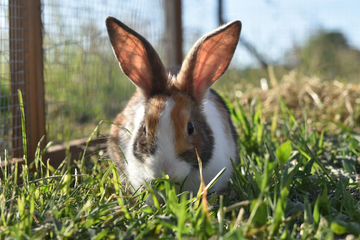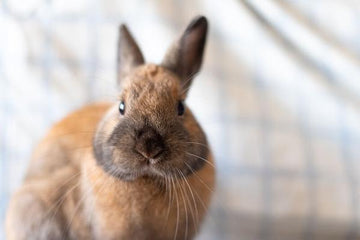Collard Greens for Rabbits: Are They Safe?
Ready to dive down the rabbit hole of leafy greens and explore the wonderful world of collard greens? If you've been wondering whether these vibrant veggies are safe and healthy for your small pet, you're in the right place!
Click Here to Check Out Our Eating Guide.

Can your fluffy friend indulge in these leafy greens? The answer is a resounding YES! Collard greens for rabbits can be a nutritious addition to their diet when given in moderation.
How Are Collard Greens Different from Other Greens?
Collard greens are big, leafy vegetables you've likely seen at the grocery store or growing in a garden. They belong to the same family as kale, mustard greens, and turnip greens. This means they're packed with vitamins, minerals, and fiber.
What makes collard greens unique is their hearty texture and slightly bitter taste. Unlike romaine or butter lettuce, collard greens hold their shape well and contain more fiber. They also have a higher calcium content than some other greens, which is great in small amounts but should be monitored to prevent excess.
Types of Collard Greens
Did you know there are different collard greens types? Each variety has a slightly different flavor and nutritional profile. Here are some common types:
Traditional Collards: Large, dark green leaves with a firm texture and a slightly bitter taste.
Baby Collards: Younger and more tender leaves with a milder flavor.
Red Collards: Leaves with reddish-purple hues that offer a slightly sweeter taste.
Flashy Collards: Ruffled, vibrant leaves with a mild and delicate flavor.
Purple-Stemmed Collards: Green leaves with striking purple stems, similar in flavor to traditional collards.
Regardless of the type, always choose fresh, crisp, and vibrant leaves for your rabbit. Avoid any that are wilted or discolored.
Slowly Introduce New Foods
Before you start serving collard greens to rabbits, it's important to introduce them gradually. Rabbits have sensitive digestive systems, and sudden dietary changes can lead to digestive upset.
Begin with a small piece and observe how your bunny reacts. Look for changes in appetite, stool consistency, or behavior. If everything looks normal after 24 hours, you can slowly increase the portion over time.
Pro-tip: Always introduce one new food at a time. This way, if your bunny has a reaction, you'll know exactly what caused it.
Are Collard Greens for Rabbits a Healthy Choice?
Yes! Collard greens are packed with nutrients that benefit rabbits when given in moderation. Here's what makes them great:

High in Fiber: Fiber is crucial for a rabbit's digestive health. Collard greens provide a good amount of fiber to help keep their gut moving properly.
Rich in Vitamins: These greens contain vitamins A, C, and K. Vitamin A supports eye health, vitamin C boosts the immune system, and vitamin K plays a role in blood clotting.
Contains Calcium: Calcium is essential for bone and teeth health. However, too much calcium can contribute to urinary issues, so it's best to feed collard greens in moderation.
Low in Sugar: Unlike carrots or some fruits, collard greens are naturally low in sugar, making them a healthy choice.
How Much Collard Greens Should Rabbits Eat?
Moderation is key when feeding collard greens to rabbits. A good rule of thumb is to offer about one cup of mixed leafy greens per two pounds of body weight per day.
Since collard greens are higher in calcium, they should only make up a portion of your rabbit's leafy green intake. Mix them with other greens like:
Romaine lettuce
Green leaf lettuce
Cilantro
Parsley
Basil
Avoid feeding collard greens every day—two to three times a week is ideal.
Can Other Small Pets Eat Collard Greens?
While collard greens for rabbits are a great choice, they may not be suitable for all small pets.

Guinea Pigs
Yes! Guinea pigs can eat collard greens, but like rabbits, they need them in moderation. Since guinea pigs cannot produce their own vitamin C, collard greens can be beneficial. However, they should be balanced with other greens with lower calcium content.
Chinchillas
No. Chinchillas have very delicate digestive systems, and collard greens are too rich for them. Stick to hay and chinchilla-specific pellets to keep their diet safe and balanced.
Keeping It Fresh
When serving collard greens for rabbits, freshness matters. Always wash the leaves thoroughly to remove any dirt or pesticides. Store them in the refrigerator and use them within a few days for the best quality.
The Verdict: Can Rabbits Eat Collard Greens?
Absolutely! Collard greens can be a healthy and nutritious treat for your bunny in moderation. They provide fiber, vitamins, and minerals that support your rabbit's overall health.
Remember to introduce them gradually, balance them with other greens, and always watch for any changes in your rabbit's digestion or behavior.
Curious about other foods that are safe for your rabbit? Check out our Eating Guide to explore a complete list of rabbit-friendly foods, along with their health ratings and nutritional benefits.

Rabbit Is It Low Maintenance or More Work Than You Think?

Signs of Rabbit Health: What You Should Know

Decoding Bunny Behavior: Understanding Rabbit Mood







